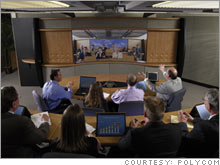|
Terror threatens, traffic snarls ... video wins When terror, pandemics and high travel costs threaten to disrupt business, virtual conferencing stands to gain. NEW YORK (CNNMoney.com) -- Who is profiting from latest air travel headaches? Take a look at video and Web conferencing firms that offer an alternative to face-to-face business meetings. Some of them are scoring major gains.
An alleged terrorist plot in London that was foiled nearly two weeks ago still is wreaking havoc on air travel as security around the world has been raised. The latest disturbance came Wednesday when a Northwest Airlines flight traveling to Mumbai was escorted back to Amsterdam due to the behavior of some "unruly passengers," CNN reported. But the increasing frequency of these kinds of air travel disruptions are providing a boost for virtual conference providers like Radvision (Charts), Polycom (Charts) and WebEx (Charts). Bigger players like Microsoft (Charts) and Cisco (Charts), which have been pushing so-called unified conferencing - which combines voice, video and data such as scheduling - also stand to gain. Conferencing firms generally enjoy a jump in business after incidents like terror scares, as companies scramble to find ways to keep their operations running smoothly, analysts said. The momentum tends to fade as travelers returns to the skies, but it gets conferencing products and services on the radar of IT purchasers. "Companies are taking a much stronger look at having some kind of business continuity back-up plan," said Bob Romano, vice president of enterprise marketing for Radvision, a company that develops products and technologies for visual communications. It isn't just terror-related incidents that are making travel more unpleasant, according to Andrew Davis, managing partner at Wainhouse Research, a market research firm that tracks the conferencing business. Concerns over pandemics, as well as surging gas and jet fuel costs, are also making business travel more inefficient and costly. Businesses are waking up to the alternatives to sending their employees out on the road, said Bob Haggerty, CEO of video conference leader Polycom. What they're finding is that video conferencing is an easy-to-use way to add productivity to their business, he said. Time to buy? Many stocks of conferencing providers were cheap heading into this year, but financial results have been better than what most investors would have anticipated, especially on the video side, said Tavis McCourt, an analyst with investment firm Morgan Keegan. That's spurred a surge in some of these shares. Web conferencing firm WebEx has climbed 44 percent in the past year, and Polycom is up nearly 40 percent. The tech-fueled Nasdaq composite, on the other hand, has stayed flat over the same period. The upbeat outlook for the industry is fueling some of the interest. The total global videoconferencing systems and services market is expected to reach $3.1 billion in 2010, growing at a compound annual growth rate of 21.7 percent, according to consulting firm Frost & Sullivan. Costs for establishing video communications networks have also declined. As more companies upgrade their Internet infrastructure, it's made it less expensive to deploy video, according to McCourt. But the industry faces a big barrier -- getting executives and other employees comfortable with video calls rather than person-to-person meetings. "The question is whether we see permanent, structural changes in the way companies do business -- whether we see the shift of resources away from travel to alternatives," Davis from Wainhouse Research said. Video conferencing requires a shift in user behavior, but the biggest thing going for it is that teenagers - tomorrow's workforce - don't have as much inhibition when it comes to communicating virtually, said Roopam Jain, principal analyst at Frost & Sullivan. "Over a period time, we'll definitely see greater adoption of video as a day-to-day communication tool," she said. McCourt does not own shares of any of the companies mentioned in this article and his firm does not do investment banking for any of the firms. |
Sponsors
|


